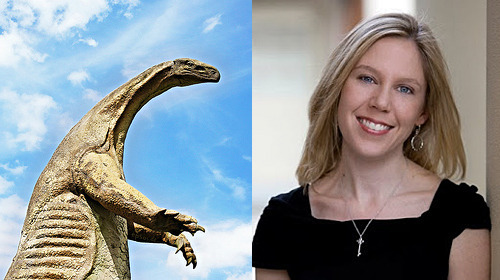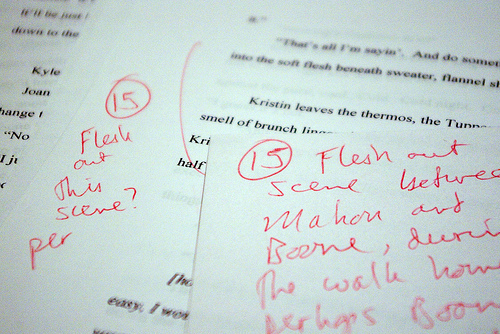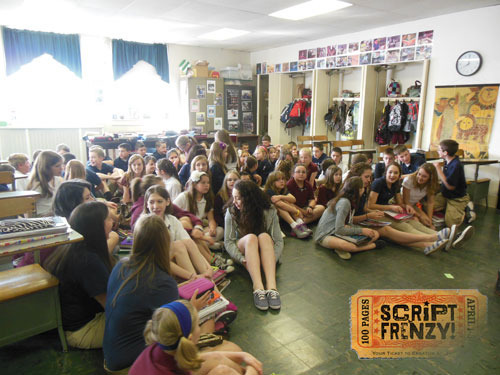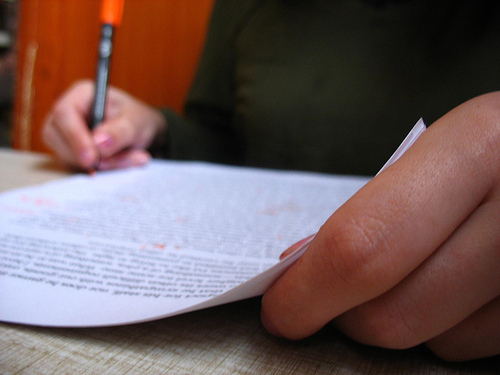Chris Baty's Blog, page 214
May 22, 2013
YWP Chronicles: How Alexis Used Her Novel to Benefit a Food Bank

Do you remember when you first began to write down your stories? Alexis Ann Davis, pictured above signing her CreateSpace-published novel in Spokane, is one of the thousands of young writers supported by the NaNoWriMo community through the Young Writers Program, and the first to be spotlighted this year:
As a participant in NaNoWriMo’s Young Writers Program, seven-year-old Alexis Ann Davis reached her word-count goal last November, but didn’t stop there. She leapt into her next endeavor, and published her novel! For some writers, publishing daydreams come complete with money, fame, and fandom. For Alexis, publishing her NaNoWriMo novel has meant helping the community, gaining a sense of accomplishment, and daring to dream big.
Alexis, who goes by Lexi, achieved her YWP writing goal with a selection of short stories titled Stories from a 6 Year Old Lexi and took advantage of the five free CreateSpace copies offered to NaNoWriMo winners.
“It was very exciting for her to see what could come of her actions,” said Alexis’ mother, Kristine Neal. “She was pleased that the time she dedicated to writing in November was something she might use to help other people and as a parent, I can say that I was impressed with her drive and initiative.”
With the help of her mother, Alexis organized a book signing on Bainbridge Island near Seattle, WA and another in Sandy, Oregon, as well as hometown signings in the Spokane area.
“Lexi and I have been active in supporting the local food bank since she was three, so she used her savings to purchase more copies of her book and sold them to raise money for our local food bank and took donations for autographs,” said Kristine. “She had her books on the shelf of a local grocery store and even landed an interview on the #1 country radio show in the region.”
Alexis, along with thousands of YWP writers around the world, is daring to share her novel and inspire others with her writing. Her voice deserves to be heard, and so does yours!
— Andrea
Photo by Kristine Neal.
May 20, 2013
4 Steps to Cure the "I Finished My First Draft" Blues

Hello once and future Campers! How are you feeling on this fine May day? Blissful and free, like the pollen drifting on the breeze from tree to tree? Exultant, like the alpenglow that graces the mountain peaks with the first light of day? Triumphant, like the grizzly bear, emerging from a long winter with her playful cubs?
If you are anything like me, those three similes probably just made you a little bit nauseous (I mean, pollen? Really? You know what that stuff is, right?). If you had a Camp NaNoWriMo experience similar to mine, you might be feeling a little spread thin. You might be feeling disillusioned. If you are anything like me, you might be feeling unsure as to how to fill these new blocks of free time.
I’ve heard this feeling called the “Post-NaNo Blues.” The creative storm has passed, but the tornado never touched down and swept you permanently off to Novel-Oz. The work-a-day world has reemerged and it doesn’t look a whole lot different than it did on March 31. Rather than feeling like a celebrated novelist, you may feel more like a tortured writer burdened by an overlong draft of… something.
It’s time to, for lack of a better cliche, see the forest for the trees. In other words: let’s find perspective. This draft will be the rock on which you will build your great novel, one revision at a time. A possible course of action:
Entrust your novel to a close friend or family member (make sure you say “keep it secret, keep it safe”) and ask them to give it back to you in a month.
Go forth into the world armed with nothing but a pocket-sized notebook, and pause only long enough to jot down poignant, novel-y things. Immerse yourself in the “real world” with gusto. Try to live like your favorite characters.
Pick a book you’ve been meaning to read for awhile, or a book by an author who inspires you. Read it. I don’t know about you, but I didn’t do much non-required reading in April. Give your own voice a chance to recuperate by immersing yourself in the voice of another.
Once that month is up and you are reunited with your novel, with any luck, it will seem fresh and new again, ready for some revising. It won’t magically seem perfect, but I suspect that, with perspective, you’ll more easily find the energy to turn that coal into a diamond.
Finally, a little dose of perspective from the writing woes of another: James Joyce began writing Ulysses in 1906 as part of a short-story collection. He published the completed first edition of the novel in 1922. It was promptly banned in both the UK and the US, unavailable in English until the US repealed the ban in 1934.
Your journey is only just beginning. Congratulations on taking that first, crucial leap.
— Mike
Photo by Flickr user firexbrat.
May 17, 2013
The Great 2013 Pep Talk Author Request Poll!

It’s time to start thinking about some very important people: our 2013 NaNoWriMo pep talkers! Every spring, we call on some of our fave authors to provide encouragement and inspiration in November. Here’s who we heard from last year, and here are our writers from 2011 and earlier.
So, who would you like to hear from? All published living authors are fair game. (Though we prefer to spread the love and not repeat writers, so be sure to check the lists above.)
Don’t be shy to tell us who you’d be most excited to see in your NaNoMailbox this fall. Share your list in the comments below!
Original photo by Debarshi Ray
May 15, 2013
The Camp Rebel Files: 4 Tips I Learned From Researching

In some ways, the result of my April doesn’t feel as satisfying as a typical NaNo month’s. I don’t have a word-packed document on my desktop or a pile of ink-stained notebooks in my backpack; I just have a ton of facts, quotes, and ideas waiting to be turned into something else.
The genre I’m most interested in—research-based creative nonfiction—requires time. When you’re trying to find out all you can about a particular topic, it’s hard to just dive in and write a complete draft in 30 days. You need to refine your focus, read background information, do interviews, and find a narrative.
Camp NaNoWriMo was the perfect opportunity to buckle down and finish these steps. And even though I only have an outline to show for it, it’s an outline with a whole lot of potential. If you’re interested in using Camp’s July session as a research and outlining month, I’ve got a few tips based on my experience:
Create a goal. What do you want to have in front of you at the end of the month? Perhaps it’s rules and a character map for your fantasy world, or chapter sketches for the next installment in your sci-fi saga.
In my case, it was completed research and a framework for my first draft. Decide on the ideal outcome of your 30 days and focus on that as your target.
Figure out how you’ll be accountable. For those writing during NaNo, word count is an easy form of accountability. But for us outliners, it’s a little more difficult. How you count and record your daily efforts is up to you, but you should be consistent no matter what.
I used hours, and I “lent” myself 1,000 words on the Camp website for every 60 minutes worked.
Manage your expectations. You may feel bad when friends are finishing with 50,000-word manuscripts, but remember your goal. What you’re doing is an important part of your writing process, and you’ll have that manuscript later on. Just keep plugging away at your planning.
Write the thing. This is the most important tip I can give you. You’re researching and outlining in order to create something bigger, and as soon as you’re done, it’s time to go for it.
I’m writing my nonfiction piece this month, and I’m excited to see my work from April pay off. Ideas I had a few weeks ago are now finding full shape on the page, spare quotes are finding their place. This will happen to you, too. Make the time to plan, then get your story out there.
— Chris
What writing project did you tackle this past April?
May 13, 2013
How to Successfully Pitch Your Novel, with Stacy McAnulty

Every year, during NaNoWriMo Pitchapalooza, Wrimos from around the world whittle their stories down to a short pitch for a chance to break into the industry with the help of pros Arielle Eckstut and David Henry Sterry, also known as the Book Doctors. (They’ll also be donating the proceeds of their upcoming Art of the Edit webinar to NaNoWriMo!)
This year, Stacy McAnulty took top honors; r ead on to find out how a dinosaur egg can turn into a winning idea! ( Click here to read Stacy’s original pitch, as well as the critique.)
Your winning pitch was about “a boy who hatches a dinosaur egg.” What inspired that idea?
In October, my son turned five. He told me he wanted “a real, live dinosaur” for his birthday. Well, they are very hard to come by. Not even available on eBay. So, what’s an author to do? Make it up. I wrote the book for him.
To be honest, my son has turned me into a dinosaur nut. In addition to my dinosaur-related picture book that will be published this October, I’m working on another middle-grade story about the discovery of the first dinosaur bones in the 1820s in England. Can you imagine what it must have been like to discover a giant jawbone, or a tooth the size of a banana? The word dinosaur wasn’t even used until the 1840s.
Dinosaurs are just fascinating, and I’m becoming obsessed. My family is even going on a dinosaur dig this summer in Wyoming!
How did you refine it down to an attention-grabbing pitch?
Cutting it down to a pitch was challenging. I tried a couple of times in February and gave up. My first completed attempt was 391 words. That needed to be whittled and reworked.
My final entry was 194 words (well under the 250 limit), and I entered it on the last day of the contest. Thank goodness for deadlines.
How did the Book Doctors add to your knowledge about pitching? Any tips for your fellow Wrimos?
I used the Book Doctors’ 10 Tips For Pitching as a starting point. My favorites are:
“Make us fall in love with your hero,” and
“Leave us with a cliffhanger.”
Once the 25 pitches were selected, I loved reading them and the feedback from the Book Doctors. I can’t believe how much I learned just from doing that!
Your children’s book Dear Santasaurus will be coming out this October from Boyds Mills Press. Congratulations! How did you pitch and publish that book?
Dear Santasaurus is my first picture book. I didn’t have to pitch that one because the editor read the entire story at a conference. Four rewrites later, she bought it. Like so much in publishing, that deal was all about luck and timing. Of course, the story had to be good, or at least have the potential to be good.
How does NaNoWriMo fit into your creative story?
I love NaNoWriMo, and I love the shirts. I think I have more shirts than wins. I’ve participated for six years and won three times.
NaNoWriMo gives me such a feeling of accomplishment. After meeting my daily goal, I experience a writer’s high, similar to a runner’s high but without the weight-loss benefit. November is the only time of year I’m truly disciplined in my writing.
Any final tips for your fellow writers?
Writers have more bad days than good days when it comes to publishing. Winning NaNoWriMo Pitchapalooza was a good day. My last good day was in October when an agent requested a full manuscript. I won’t tell you how many “bad days” I’ve had in between. Celebrate the good days!
— Andrea
Photo by Flickr user epSos.de, and courtesy of Stacy McAnulty.
May 10, 2013
Revising Your Novel: The Good, the Bad, and the Ugly

Arielle Eckstut and David Henry Sterry, aka the Book Doctors, spend their days working with authors to hone their manuscripts. On Tuesday, May 14, they’ll be hosting a webinar to benefit NaNoWriMo, called The Art of the Edit , where they’ll guide participants through their steps for revision. They shared a taste of what they’ll discuss with us.
One of the things that separates amateurs from professionals is their ability to rewrite their novels, to transform them from beautiful but unshaped pieces of clay into glorious works of art that take the breath away. We look at multiple aspects of the novel as we edit—often doing individual edits for each aspect. Here are the big ones:
Character arc. How does your character change from the beginning to the end of the story? What does s/he desperately want at the beginning of the story that s/he doesn’t have? What is the Achilles’ heel that is stopping him/her?
Building suspense. It’s very difficult to know how much information to give and how much to conceal. Many times in the first draft of a story a writer will tell us too much, too soon, killing the suspense. Or they tell us too little, and we don’t feel that uncontrollable drive to read the next line, the next page, the next chapter.
Opening chapters. Closing chapters. Sometimes starting a chapter in the middle of the scene will engage a reader instantly. Then you can go back and fill in information as needed. Similarly, to leave us on a cliffhanger at the end of the chapter is a surefire way to keep the pages turning.
Redundancy. In early drafts, writers tend to tell us what they’re going to tell us; then they tell us what they’re telling us; and then they sometimes even tell us what they’ve told us! Look for repetition on the sentence, paragraph, chapter and book level.
Show. Don’t Tell. It’s the oldest cliché in writing. And yet, time and again we see writers committing this cardinal sin. Don’t draw conclusions for us. Don’t tell us a character is mean, or nice, or pretty. Show us word pictures, show us action, and let us be the judge.
Clichés. Speaking of clichés, you have to root them out of your manuscript like a dog chewing on a bone. No, wait a minute; you have to work like a dog till the cows come home because it’s not over till the fat lady sings. Seriously, it’s fascinating how you can turn a cliché into something new and fresh.
Dialogue. There’s a fine line between dialogue that rings true, feels authentic and real, and dialogue where—if you listen closely—you can actually hear the writer’s fingers pounding away on the keys.
Pacing. A book, like life, has rhythms. Sometimes things move very quickly, and sometimes we need a moment to take a breath. Sometimes things are loud and booming, sometimes soft and quiet.
Trick words. Without even knowing it, we tend to rely on certain words or phrases over and over and over again. When you do a search for these words and phrases, you’ll be shocked by how many times they come up in your manuscript, pleasantly surprised by how easy they are to get rid of, and overjoyed by how excising them can make your book so much better.
Photo by Flickr user greg.turner.
May 8, 2013
The Young Writers Program: Writing Geeks, Sci-Fi Plays, and Hunting Your Word Count

This past April, Camp NaNoWriMo allowed participants to choose both their word count and their preferred writing form, whether that was a script, short story, novel, poem, or even the back of a cereal box.
Educator Cynthia Garcia took the opportunity to keep alive the spirit of Script Frenzy, a retired program that challenged people to write 100 pages of a script in 30 days. Cynthia hosts two NaNoWriMo events every year at Fairmont Catholic School as an extracurricular activity for students. Since 2010, the participants have grown from twenty to 83.
“NaNoWriMo and Script Frenzy have been the most dazzlingly successful of our projects,” said Cynthia. “Students are engaged with the writing, they are engaged with the project, and they are engaged with each other. They even share their writing with their parents and friends outside school, which I think is terrific, as it makes it that much more meaningful to them.”
As a middle school teacher of English, religion, and art, Cynthia has witnessed the afterschool program expand from “writing geeks” to include every type of student, including academic underachievers.
“These programs are for everybody, and they are especially great for kids who are creative but don’t have a good outlet for their creativity in their daily classroom activities. I have many students who really struggle to produce 300 words for a classroom writing assignment and yet can pound out pages of a novel or a play and think nothing of it.”
She has found that NaNoWriMo’s combination of disciplined daily writing, goal-setting, and “upbeat, fun, kid-friendly tone” keeps students engaged, no matter their initial level of interest in writing.
“I’ve been especially delighted to see how NaNo and Script Frenzy have caught on with the boys,” she said. “Middle school boys are notoriously not big fans of language arts, but we routinely have boys participating at all grade levels. Last year I had a great group of popular, athletic eighth grade boys who wrote a science fiction play and performed it during our Frenzy Festival.”
NaNoWriMo also creates community and friendly competition among students who connect over plot twists, word counts, and character development.
“I love all the great motivators that the programs offer—the progress chart, pencils, stickers, web info, online word count tracking, t-shirts, parties, ideas from other teachers—they help us to celebrate writing and make it accessible to our whole school community.”
Many students even take NaNoWriMo outside of the classroom.
“The first year I did NaNo, one of my sixth graders told me that since hunting season opened in November, he had been forced to take a notebook to his hunting camp and write by hand, so that he wouldn’t fall behind on his word count.”
For many students, NaNoWriMo’s programs are more than a headlong dive into a creative writing adventure. They provide a safe space for students to learn and explore the drama in their own lives.
Cynthia says, “I’ve had students use their writing to process and come to terms with diverse issues: moving, illness, death in the family, peer tensions, sibling problems—practically everything shows up in their fiction. Middle schoolers live ‘drama’ every day, but when they write drama, it gives them a chance to look at it with some perspective, some sense of order and control.”
Are you keeping the Frenzy alive? Tell us about it!
— Andrea
May 6, 2013
"Walk into a bookshop and you will see books that you love and books that you hate, books that were..."
The only thing they all have in common is that their authors finished them, sooner or later.”
- Nick Hornby, on the crucial first step towards seeing your book in shops.
May 3, 2013
A Note from Your Beta Reader: 4 Tips for Receiving Feedback

For a long time, I considered myself more an editor than a writer. And if I was being really honest, as I’m sitting in this office writing this to hundreds of creative and dedicated Wrimos, I’d still say my strong suit is helping other’s write.
That being said, I’ve been on the receiving end of some fairly harsh writing criticism: professors telling me that my argument is unsupportable, or friends pointing out the skewed ratio of fluff to substance in my essays. And it sucks. Because that’s my writing, and that’s me. All of those deer-in-red-penned-headlights experiences have come to inform my edits, and there are a few things I always tell my friends when they hand over their precious drafts:
Clone me!
Well, not really. That could create some tricky evil-twin scenarios in which I may not prevail. But definitely don’t let me be the solo-editor. I’m a reader with a distinct taste and skill-set that has been informed by my own life experiences. Just because I don’t like something doesn’t mean it should be thrown out entirely. If a few other people agree with me, though, then it might be time to “kill those darlings.”
Don’t look at me; I’m reviewing!
Seriously. If you’re in a writing group, and you’re in the midst of a group editing session, don’t stare down your beta reader. I can always feel the hot, laser-like glare of a writer anxiously awaiting my notes. This is the moment where my mind usually wanders.
“They’re looking at me. Are they judging my edits before they see them? Or are they just judging my hair? Does my hair look okay? Should I dye it violet? Hmm…violet.”
Vain, yes, but you get the picture. Give your reader some space and time, and you’ll get focused, detailed notes.
Speaking of judgement…
I’m not reviewing you as a writer, just this draft.
This is something I’ve become acutely aware of making clear since having my own writing workshopped more. When someone tells you to move around some commas, or to focus less on a specific scene, it’s not an attack on your writing as a whole or even the piece as a whole.
I’ve also found that this is the moment where a dialogue between writer and editor can open up and be most helpful. You can talk through what the scene could look like from another angle, or you could add another dimension to your character by splicing in something new.
Fresh looks at one’s writing like this can be lost by getting overly defensive. I know, because I’ve done it (imagine real tears over my edited draft, and a fairly baffled editor). It was my writing that suffered the consequences.
Let me read the finished product! Please?
Usually, I can deal if this never happens, but I do wonder about what the characters and plot end up looking like after that first revision. Sometimes that wonder borders on obsession. So, spare your beta readers the embarrassment of begging and harassing you for a final draft! They read for pleasure, too, and your writing is no exception. Your work is fabulous; share the love.
What do you tell your writer friends and colleagues before looking over their work? And what would you most want to hear from your beta reader?
— Shelby
Photo by Flickr user Orin Zebest.
May 1, 2013
The Writer's Road from First Draft to Submission

Congratulations, writer! You wrote a novel! …Now what? Kelly Loy Gilbert, whose first novel, City on a Hill, will be published in 2014, takes us from first draft to publication, and offers her best advice for each stage of the journey:
I’d been working on the same novel for four years, so when I decided to tackle a new project, it was jarring to start a whole new world where I didn’t know anyone or anything. The total freedom was, actually, incredibly paralyzing: why not have zombies show up at a high school? Really, when you’re staring at your blank pages at twelve a.m., there are a lot of ideas that seem a hell of a lot better than the ones you have.
I wrote a draft NaNoWriMo-style to get everything onto the page. Writing something at that speed is immersive: the world of the story starts to bleed into your own, and it can be disorienting. But at the same time, it works. The beauty of NaNoWriMo is that you’ve pushed yourself to create something out of nothing, and all at once—in just thirty days!—you have the raw material to mold into the story you want to tell.
Putting feedback to use
I sent my draft to my agent. When someone’s reading a very rough draft, it can be hard to know what to do with their feedback. Treat the feedback as a way to get at the real question: what is the story that I really want to tell? What’s at its heart?
I was asked one question about the narrator: “If he knew what he was doing was wrong, why did he do it?” And I thought about that for a few weeks: Why did he? There were the obvious, plot-based reasons, but that didn’t feel like enough. Then I started thinking in broader terms: why do any of us do things we know are wrong, or things we aren’t proud of? That question eventually shaped what I was thinking about my characters and the heart of my story arc.
Shaping your second draft
The second draft is about sifting through the words and culling the ones that you still want—which can mean dismantling the entire thing. I got rid of a few characters, resurrected one who’d been dead in the first draft, gave others total personality makeovers. I changed the setting and timeline of the story. I removed big plot points of the first draft and, once I knew the characters better, looked for more organic ways they might find themselves in places they’d never expected to.
Waiting for your book’s fate
As much as I find plenty of things to moan about while actually writing (the decisions! the awful first drafts! the carpal tunnel!), actively writing is really the best part of the process. You’re productive, and the future of your project is bright and full of possibility. Then you hand it over to wait, and suddenly the flaws seem magnified, and, well, stress-eating a ton of gummy bears seems like a great idea.
The submissions process is tough. Writing is so active: there you are, the omnipotent god of your own world, making storms howl and cities crumble at your whim—and then you’re suddenly subject to the whims of strangers. When you’re waiting, anything longer than five minutes feels like eons. (I was lucky this time, because my book sold relatively quickly!)
Looking at the road ahead
You’re at the beginning of your journey. Take some time to celebrate your accomplishment, and take a break from your novel if you need it. Then look ahead to the second draft. Remember, you’re allowed to take everything apart more than once, and to let your beloved characters live different lives until you can pick the ones that work best for them.
The thing is: sometimes the heart of the story you want to tell takes a little time to uncover. Congratulations on bringing your world to life, and beginning the search for its beating heart.
Kelly Loy Gilbert wrote her first-ever ‘novel’ in fourth grade, and has been writing ever since. Her first novel, City on a Hill, will be published by Disney-Hyperion in Spring/Summer 2014. She lives in the San Francisco Bay Area with her scientist husband. Her dream job would involve writing and her superpower of identifying Jelly Belly flavors by sight.
Photo by Flickr user Stuck in Customs.
Chris Baty's Blog
- Chris Baty's profile
- 63 followers




